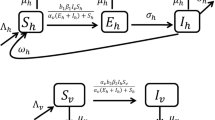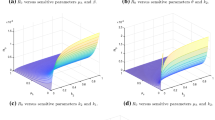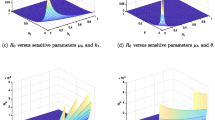Abstract
Cutaneous leishmaniasis is a vector-borne disease transmitted to humans by sandflies. In this paper, we develop a mathematical model which takes into account the seasonality of the vector population and the distribution of the latent period from infection to symptoms in humans. Parameters are fitted to real data from the province of Chichaoua, Morocco. We also introduce a generalization of the definition of the basic reproduction number R 0 which is adapted to periodic environments. This R 0 is estimated numerically for the epidemic in Chichaoua; \(R_0\simeq\) 1.94. The model suggests that the epidemic could be stopped if the vector population were reduced by a factor \((R_0)^2\simeq\) 3.76.
Similar content being viewed by others
References
Anderson R.M., May R.M. (1991) Infectious Diseases of Humans – Dynamics and Control. Oxford University Press, Oxford
Anita S., Iannelli M., Kim M.Y., Park E.J. (1998) Optimal harvesting for periodic age-dependent population dynamics. SIAM J. Appl. Math. 58, 1648–1666
Ben Salah A., Smaoui H., Mbarki L., Anderson R.M., Ben Ismaïl R. (1994) Développement d’un modèle mathématique de la dynamique de transmission de la leishmaniose canine. Archs. Inst. Pasteur Tunis 71, 431–438
Burattini M.N., Coutinho F.A.B., Lopez L.F., Massad E. (1998) Modelling the dynamics of leishmaniasis considering human, animal host and vector populations. J. Biol. Syst. 6, 337–356
Chaves L.F., Hernandez M.J. (2004) Mathematical modelling of American Cutaneous Leishmaniasis: incidental hosts and threshold conditions for infection persistence. Acta Tropica 92, 245–252
Coale A.J. (1972) The Growth and Structure of Human Populations – a Mathematical Investigation. Princeton University Press, Princeton
Desjeux P. (2004) Leishmaniasis: current situation and new perspectives. Comp. Immunol. Microbiol. Infect. Dis. 27, 305–318
Diekmann O., Heesterbeek J.A.P. (2000) Mathematical Epidemiology of Infectious Diseases – Model Building, Analysis and Interpretation. Wiley, Chichester
Feliciangeli M.D. (2004) Natural breeding places of phlebotomine sandflies. Med. Vet. Entomol. 18, 71–80
Guernaoui S., Boumezzough A., Pesson B., Pichon G. (2005) Entomological investigations in Chichaoua: an emerging epidemic focus of cutaneous leishmaniasis in Morocco. J. Med. Entomol. 42, 697–701
Hasibeder G., Dye C., Carpenter J. (1992) Mathematical modelling and theory for estimating the basic reproduction number of canine leishmaniasis. Parasitology 105, 43–53
Heesterbeek J.A.P., Roberts M.G. (1995) Threshold quantities for helminth infections. J. Math. Biol. 33, 415–434
Heesterbeek J.A.P., Roberts M.G. (1995) Threshold quantities for infectious diseases in periodic environments. J. Biol. Syst. 3, 779–787
Jagers P., Nerman O. (1985) Branching processes in periodically varying environment. Ann. Prob. 13, 254–268
Kerr S.F., Grant W.E., Dronen N.O Jr. (1997) A simulation model of the infection cycle of Leishmania mexicana in Neotoma micropus. Ecol. Modell. 98, 187–197
Lotka A.J. (1923) Contribution to the analysis of malaria epidemiology. Am. J. Hygiene 3, 1–121
Kermack W.O., McKendrick A.G. (1927) A contribution to the mathematical theory of epidemics. Proc. R. Soc. Lond A 115, 700–721
Ma J., Ma Z. (2006) Epidemic threshold conditions for seasonally forced SEIR models. Math. Biosci. Eng. 3, 161–172
Ministère de la Santé Publique du Maroc Etat d’avancement des programmes de lutte contre les maladies parasitaires. Direction de l’épidémiologie et de lutte contre les maladies, Rabat (2001)
Rabinovich J.E., Feliciangeli M.D. (2004) Parameters of Leishmania Braziliensis transmission by indoor Lutzomyia Ovallesi in Venezuela. Am. J. Trop. Med. Hygiene. 70, 373–382
Ross R. (1911) The Prevention of Malaria. John Murray, London
Thieme H.R. (1984) Renewal theorems for linear periodic Volterra integral equations. J. Integral Equations 7, 253–277
Williams B.G., Dye C. (1997) Infectious disease persistence when transmission varies seasonally. Math. Biosci. 145, 77–88
Author information
Authors and Affiliations
Corresponding author
Rights and permissions
About this article
Cite this article
Bacaër, N., Guernaoui, S. The epidemic threshold of vector-borne diseases with seasonality. J. Math. Biol. 53, 421–436 (2006). https://doi.org/10.1007/s00285-006-0015-0
Received:
Revised:
Published:
Issue Date:
DOI: https://doi.org/10.1007/s00285-006-0015-0




